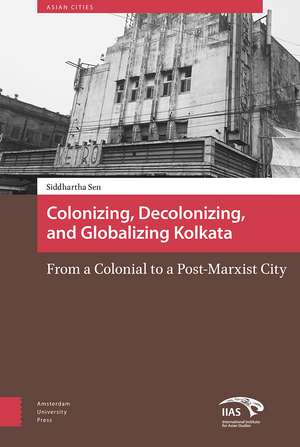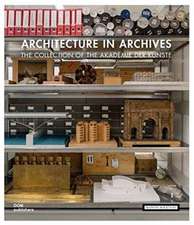Colonizing, Decolonizing, and Globalizing Kolkat – From a Colonial to a Post–Marxist City: Asian Cities
Autor Siddhartha Senen Limba Engleză Hardback – 15 iun 2017
Colonising, Decolonising, and Globalising Kolkata offers an extended analysis of the architecture of Kolkata from the earliest days of colonialism through independence and on into the twenty-first century, all set in the larger context of Indian cities and architecture. What Siddhartha Sen shows is the transformation of a colonial city into a Marxist one—and ongoing attempts to further transform it into a global city. Richly illustrated, the book carefully situates architecture, design, and urban planning within Kolkata’s political economy and social milieu.
Preț: 847.02 lei
Preț vechi: 930.79 lei
-9% Nou
Puncte Express: 1271
Preț estimativ în valută:
162.08€ • 169.65$ • 134.90£
162.08€ • 169.65$ • 134.90£
Carte disponibilă
Livrare economică 10-24 martie
Livrare express 21-27 februarie pentru 35.08 lei
Preluare comenzi: 021 569.72.76
Specificații
ISBN-13: 9789462981119
ISBN-10: 9462981116
Pagini: 292
Ilustrații: 92 halftones, 5 line drawings
Dimensiuni: 164 x 238 x 21 mm
Greutate: 0.58 kg
Editura: Amsterdam University Press
Seria Asian Cities
ISBN-10: 9462981116
Pagini: 292
Ilustrații: 92 halftones, 5 line drawings
Dimensiuni: 164 x 238 x 21 mm
Greutate: 0.58 kg
Editura: Amsterdam University Press
Seria Asian Cities
Notă biografică
Siddhartha Sen is interim assistant dean of the School of Architecture and Planning and the director of the Graduate Program in City and Regional Planning at Morgan State University in Baltimore.
Cuprins
Acknowledgements
A Note to Readers
1 Overture
Introduction
Scope of the Book
Analytical Framework
The Concept of the State in India
Socialism, Communism, and Marxism
Data Sources
Organization of the Book
2 Colonizing Kolkata
From a City of Huts to a City of Palaces
Founding of Kolkata
Kolkata’s Early Urbanism
Spatial Restructuring of Kolkata and the Emergence of Social and Political as the Dominant Planning Paradigm
Kolkata’s Transformation to a City of Palaces
Emergence of Architecture as a Symbol of Power
Creating a Healthier and Beautiful City for the British: Emergence of a New Paradigm for Planning
Early Municipal Administration in Kolkata
The Rise of the British and the Demise of Other European Settlements around Kolkata
Haora’s Urbanism
3 Building a Neo-Classical, Beautiful, and Clean City
The Rise and Decline of British Imperial Urbanism
Consolidation of British Power: Making Kolkata a Neo-Classical City
The Neo-Classical Architectural Influence on the Bengali Elite
Orientalist Discourse on Architecture and Kolkata
Victoria Memorial Hall: Neo-Classiscal Revival in Kolkata
The Modern Indian Architecture Movement
Limited Modernism in Kolkata
Transforming Kolkata into a Cleaner and Healthier city for the British
Shifting the Discourse to Bustees as a Source of Disease
The Calcutta Improvement Trust and E.P. Richards’s Plan for Kolkata
Sir Patrick Geddes’s Plan for the Burra Bazaar
Racial Segregation
Municipal Administration in Kolkata and the Expansion of Its Boundaries
Haora’s Transformation to a Coolie Town
4 Decolonizing Kolkata
From an American Planning Paradigm to a Marxist City
Chandigarh: A Defining Moment in India’s Search for Post-Colonial Urbanism
Revivalist Architecture and the Search for Post-Colonial Architectural Identity
Lack of a Search for Post-Colonial Architecture in Kolkata
In Search of Post-Colonial Planning: An Overview
The Initial Acts of Decolonization in Kolkata
Material Legacies of Colonial Planning and Kolkata’s Post-Colonial Urban Problems
Political Economy of Post-Colonial Kolkata and Its Urban Problems
Administrative Structure and the Continuation of the Colonial Legacy in the Immediate Post-Colonial Period
Western Discourse on Kolkata and the Advent of Western Planning
The Calcutta Metropolitan Planning Organisation and the Export of the American Planning Paradigm to Kolkata
The Fear of Communism and the Formation of the Kolkata Metropolitan Development Authority
Political climate and Municipal Reform
The Infiltration of the Grassroots Space by the Communist Party of India (Marxist) and Its Allies
New Towns around Kolkata
Haora’s Post-Colonial Urbanism
5 Globalising Kolkata
A Late Bloomer
Emergence of New Market-Driven Architectural Forms in India
Why Kolkata Was a Late Bloomer
Making Kolkata Attractive to Capital: Operation Sunshine and the Proposal to Remove Rickshaw Pullers
Singur and Nandigram: The Changing Priorities of the Left Front
Kolkata’s Population Growth, Territorial Changes, and Administrative Structuree
Liberalization and the Changing Role of the Kolkata Metropolitan
Development Authority and the Kolkata Muncipal Corporation
Kolkata’s Private Townships and Gated Communities: Emergence of Real Eastate-Driven Development
Kolkata’s Office Buildings for the Service and Financial Sectors, SEZs, and IT Parks and Complexes
Shopping Malls
Emergence of New Planning Paradigms: State-Regulated Townships and Private Townships
Rajarhat
Haora’s Global Urbanism
Kolkata West International City
6 Concluding Remarks
Glossary
List of Abbreviations
Bibliography
Index
A Note to Readers
1 Overture
Introduction
Scope of the Book
Analytical Framework
The Concept of the State in India
Socialism, Communism, and Marxism
Data Sources
Organization of the Book
2 Colonizing Kolkata
From a City of Huts to a City of Palaces
Founding of Kolkata
Kolkata’s Early Urbanism
Spatial Restructuring of Kolkata and the Emergence of Social and Political as the Dominant Planning Paradigm
Kolkata’s Transformation to a City of Palaces
Emergence of Architecture as a Symbol of Power
Creating a Healthier and Beautiful City for the British: Emergence of a New Paradigm for Planning
Early Municipal Administration in Kolkata
The Rise of the British and the Demise of Other European Settlements around Kolkata
Haora’s Urbanism
3 Building a Neo-Classical, Beautiful, and Clean City
The Rise and Decline of British Imperial Urbanism
Consolidation of British Power: Making Kolkata a Neo-Classical City
The Neo-Classical Architectural Influence on the Bengali Elite
Orientalist Discourse on Architecture and Kolkata
Victoria Memorial Hall: Neo-Classiscal Revival in Kolkata
The Modern Indian Architecture Movement
Limited Modernism in Kolkata
Transforming Kolkata into a Cleaner and Healthier city for the British
Shifting the Discourse to Bustees as a Source of Disease
The Calcutta Improvement Trust and E.P. Richards’s Plan for Kolkata
Sir Patrick Geddes’s Plan for the Burra Bazaar
Racial Segregation
Municipal Administration in Kolkata and the Expansion of Its Boundaries
Haora’s Transformation to a Coolie Town
4 Decolonizing Kolkata
From an American Planning Paradigm to a Marxist City
Chandigarh: A Defining Moment in India’s Search for Post-Colonial Urbanism
Revivalist Architecture and the Search for Post-Colonial Architectural Identity
Lack of a Search for Post-Colonial Architecture in Kolkata
In Search of Post-Colonial Planning: An Overview
The Initial Acts of Decolonization in Kolkata
Material Legacies of Colonial Planning and Kolkata’s Post-Colonial Urban Problems
Political Economy of Post-Colonial Kolkata and Its Urban Problems
Administrative Structure and the Continuation of the Colonial Legacy in the Immediate Post-Colonial Period
Western Discourse on Kolkata and the Advent of Western Planning
The Calcutta Metropolitan Planning Organisation and the Export of the American Planning Paradigm to Kolkata
The Fear of Communism and the Formation of the Kolkata Metropolitan Development Authority
Political climate and Municipal Reform
The Infiltration of the Grassroots Space by the Communist Party of India (Marxist) and Its Allies
New Towns around Kolkata
Haora’s Post-Colonial Urbanism
5 Globalising Kolkata
A Late Bloomer
Emergence of New Market-Driven Architectural Forms in India
Why Kolkata Was a Late Bloomer
Making Kolkata Attractive to Capital: Operation Sunshine and the Proposal to Remove Rickshaw Pullers
Singur and Nandigram: The Changing Priorities of the Left Front
Kolkata’s Population Growth, Territorial Changes, and Administrative Structuree
Liberalization and the Changing Role of the Kolkata Metropolitan
Development Authority and the Kolkata Muncipal Corporation
Kolkata’s Private Townships and Gated Communities: Emergence of Real Eastate-Driven Development
Kolkata’s Office Buildings for the Service and Financial Sectors, SEZs, and IT Parks and Complexes
Shopping Malls
Emergence of New Planning Paradigms: State-Regulated Townships and Private Townships
Rajarhat
Haora’s Global Urbanism
Kolkata West International City
6 Concluding Remarks
Glossary
List of Abbreviations
Bibliography
Index

















